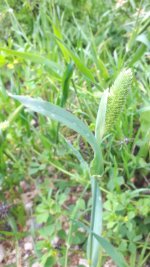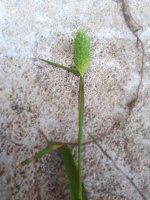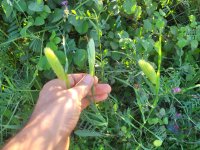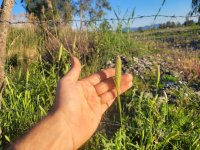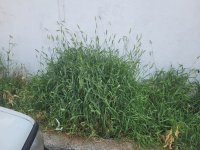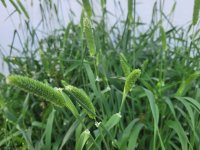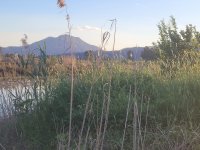ok back re re-arranged info..but as far as deleted posts go.....it's like Here today, gone tomorrow...if you find a good strain share seed, if you come across information take it in now, and then...remember it...that's the old ways..now excuse my ramblings
.
Ok,
Gramine....
(3-(dimethylaminomethyl)-indole)
..I'm not sure there has ever been any evidence of Gramine acute toxicity..i'm not sure where the worry about gramine originates...erowid?
As far as I can see it is based on a misunderstanding of early research into the cause of the Phalaris 'Staggers syndrome'...they were looking to see if alkaloids were responsible, and gave animals ridiculous amounts of gramine to try and induce toxic symptoms...they also gave them Hordenine and 5meo-DMT, the latter of which was the most toxic in that context..
..from Bourke et al 1988 (Aust Vet J. 1988, Jul; 65(7):218-20.) :-
The acute toxicity for sheep of 3 alkaloids that occur in Phalaris acquatica was examined by intravenous and oral administration. The lowest tested dose rates that produced clinically observed signs were, for 5-methoxy dimethyltryptamine, 0.1 mg/kg body weight intravenously and 40 mg/kg orally; for gramine, 10 mg/kg intravenously and 500 mg/kg orally; and for hordenine, 20 mg/kg intravenously and 800 mg/kg orally. All induced the clinical signs observed in the nervous form of phalaris toxicity, but none induced the cardiac, sudden death.
...the Staggers syndrome has now been found to not be caused by any of the alkaloids..As I said in my deleted post:
It's in this post in the Phalaris=the way of the Future thread
[it's caused by a combination of grazing on lots of grass with high ammonium levels, and a compound (as yet unknown but potentially from a fungus, as only some grass does it) that affects the animals ability to metabolize nitrogen, resulting in nitrogen overdose]
There's a lot of great info various nexians have posted in that thread, and it can be hard to remember where things are, but there's a well there..
so,
how toxic is gramine? not very, is my conclusion, from the evidence i’ve seen….sure anything is toxic if given enough (like 500mg gramine per kg the sheep were! Again - per kg, and even then most were ok after a bout of 'nervous symptoms' )
Gramine is in
Oats and
Barley...most of you have had gramine, even regularly.....
i was going to post a bunch of papers, theres been a renaissance in gramine research, but so as not to clutter..
this paper looked precisely at how toxic is gramine...
Safety evaluation of an oat grain alkaloid gramine by genotoxicity assays
Manash Pratim Pathak et al. Drug Chem Toxicol. 2018 Apr.
..from the abstract:
Gramine is a natural indole alkaloid that has been isolated from different raw plants occurring mainly in Avena sativa, etc. The study was aimed to investigate the possible in vitro antioxidant, in vitro mutagenic, in vitro antimutagenic, and in vivo genotoxic activity of gramine using ferric reducing ability of plasma (FRAP) assay, Metal chelating, Ames bacterial reverse mutation test, and the mouse bone marrow micronucleus assay as well as chromosomal aberration. Four concentrations of gramine viz. 250, 500, 1000, and 2000 μg/mL were evaluated…
i.e. 0.1, 0.2, and 0.3 × the LD50 of gramine (i.e. 50 mg/kg, 100 mg/kg, and 150 mg/kg) were administered orally to either sex of Swiss albino mice for 48 h to study the genotoxic activity in micronucleus assay as well as chromosomal aberration.
Gramine showed potent antioxidant activity in both the assay. Gramine at the given dose lacks mutagenicity as well as found to possess antimutagenic efficacy. Interestingly, S9 enzymes increase the antimutagenic activity in a dose-dependent manner. There was no significant increase in the frequency of micronucleated polychromatic erythrocytes (MNPCEs), as well as no significant difference in the percentage of chromosomal aberrations was observed between the gramine groups and the negative groups but percentage of polychromatic erythrocytes (PCEs) is found to be higher in all the gramine groups. These results indicate significant antioxidant, non-mutagenic as well as non-genotoxic activity of gramine in vitro and in vivo in the given doses.
dithyramb..as far as being a possible '
blocking agent', as mentioned in your earlier post, i don't see much evidence that it would block effects of DMT, and in fact see a lot of evidence of its psychoactivity.
from the deleted post:
The area of antagonists vs inverse agonists (for blocking vs having activity) is a bit fuzzy, so I don't really know, but I would think it would have to be present in much greater quantities than what's in Phalaris generally to have much of a shot at that.. .
It's also worth noting that DMT acts most strongly on 5ht7 (a highly interesting receptor)
But, Gramine doesn't appear to block completely the total 5ht2 receptor, as in animal experiments it's been shown to have CNS effects of its own.
from Phalaris=the Way thread:-
'.."may have ephidrine-like effects" is taken from Voogelbreinder (2009)..
that book also notes that gramine appaered a few years ago as a purported human health supplement..from Designed Nutritional Products:
"Suggested use is as a sedative and nerve tonic"...suggested doses are 100-400mg (see p.403) '
It was also apparently "behaivourally-active in rats" [Gessner et al. 1961]
and if we take it’s presence in Avena species as an indicator, it may have some sedative effects..
Clearly the psychoactivity of gramine in humans is an area open for research…the effects of high doses on animals indicated similar nervous activity to dmt & 5meo…
Now, of course the amounts present in Phalaris are on average really quite small…
again from the deleted post:
As an example, there is an analysis of a Phalaris strain early in the way of the future thread by benzyme showing of total alkaloid in that particular case, 90% was DMT, and the rest mainly gramine..Now, if 30mg of alkaloid was vaporised, that would be 27mg dmt and 3mg gramine...I would be sceptical if that example would be enough to 'block' the effects of DMT through being a 5ht2a antagonist..it may be enough to give the experience a subtly different quality..
But, I leave it to everyone to draw their own conclusions..
Stay well and safe all



